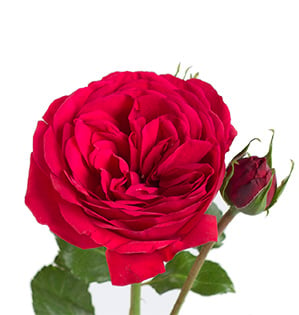Rose Garden

Common Names: Garden Rose, Cultivated Rose, Old-Fashioned Rose
Botanical names: Rosa spp.
Availability: Year round.
Vase life: 4 to 16 days.
Storage temperatures: 34 - 36 degrees Fahrenheit.
Ethylene Sensitive: Yes.
Description: Garden roses come in various shapes and sizes, ranging from delicate, single-petaled blooms to large, densely packed flowers with many layers of petals.One of the hallmarks of garden roses is their intoxicating fragrance. Many varieties boast rich, sweet, and complex scents that can perfume an entire garden or room.
Color: Very wide range of colors. Red, Orange, Yellow, Lavender, Pink, White
Botanical facts: Apples, peaches, pears, and plums are all from the Rose family (Rosaceae). If you look closely at the flowers on these herbs, shrubs, and trees, you will notice the similarities.
Design notes: Roses are used in a wide range of floral designs, bouquets, and arrangements as well as corsage and wedding flowers. Garden roses in particular are very popular for birdal and wedding designs.
Purchasing hints: Purchase tight, semi-firm heads just beginning to open. The stems should be straight, strong and unscarred. Leaves should be dark green and turgid.
Conditioning: Remove all foliage that will be below the water line. Carefully remove thorns using a "Rose Glove." Cut stem ends with a sharp knife. Hydrate in a solution of water and commercial floral food for two hours before storage or usage. If roses are conditioned properly, they should have a long vase life, open completely, and never have a "bent neck." If your roses are wilting, check out the "emergency care" in our care & handling section.
Additional notes: Roses are perhaps the best-known flowers in the world. They are cultivated from South America to Africa, from Eastern Europe to the Far East. In many countries roses are strongly connected to special events, ceremonies, and symbolic events. In Europe and America, roses are synonymous with Valentine's Day, a floral symbol of love and passion. Clay tablets excavated in the temples of Ur in Iraq speak of the delivery of large quantities of rose water intended for the sultan of Bagdad. The sultan used no fewer than 30,000 jars of rose water a year to make his rooms smell nice for his extensive harem. But refreshing harems was not the only purpose for which rose water was used. The Saracen general Saladin sent camel caravans loaded with rose water through his empire to cleanse the mosques after 'impure' crusaders had occupied the prayer rooms. And what about the flower itself, the rose? Saladin recaptured Jerusalem and put an end to the Second Crusade. The crusaders returned to the West with rose plants, which were then cultivated by monks in their monastery gardens not for their beauty, but - like lilies - as an ingredient for medicine. Rose water was successfully used to cure all kinds of ailments, such as trembling, constipation, drunkenness, skin and throat infections and insomnia. There is some truth in this, as we now know that Rosa rugosa hips contain high levels of vitamin C. Until the early 19th century, dried rose petals were believed to have mysterious powers. Napoleon gave his officers bags of rose petals to boil in white wine to cure lead poisoning from bullet wounds. Even today, rose water is still used to refresh the hands before a feast or a festive greeting, from the Middle East to northern India. Roses have an enchanting scent. Cleopatra covered the floors of her palace with a thick layer of rose petals every day. The mattresses and pillows of her bed were stuffed with rose petals, too. Cleopatra also had the sails of her royal barge soaked in rose water. When the breezes filled the sails, the scent of roses filled the air. It is said that the citizens along the Nile could smell Cleoprata's ship well before they saw it. When the Roman conqueror Mark Anthony climbed aboard her ship he immediately fell in love with her. This alone makes the rose the flower of love par excellence. But there is more to link roses with love. There is a special rose language, invented as a secret means of communication between lovers who were not allowed to express their love for one another openly: again in the harems of the Middle East. In the mid-18th century Lady Mary Wortley Montagu, the wife of the British ambassador in Constantinople, described this in her letters, which were published after her death. These letters inspired many books on the language of flowers, each describing the secret message hidden in each flower. A red rose bud stands for budding desire, while an open white rose asks: "Will you love me?" An open red rose: "I'm full of love and desire;" but an open yellow rose asks: "Don't you love me any more?" Give your lover a rose and she will come back to you, perhaps. Or adorn your home with a bouquet of red roses heavy with the scent of love - and dream of Anthony and Cleopatra and of the sun setting on the Nile. If the "language of flowers" is of interest to you, then you would enjoy the book "Tussie-Mussies" by Geraldine Adamich Laufer. It contains an outstanding glossary on the vocabulary of flowers.

